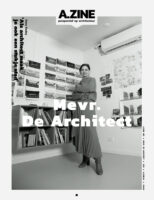The Terrestrial Style of Marie José van Hee
Published in: Mevrouw De Architect, A-ZINE #1, 2021
 Of all women in architecture, I owe most to the Ghent architect Marie José van Hee. In the 1990s, I was introduced to her work at an exhibition at De Singel in Antwerp. It was accompanied by a catalogue that became one of my dearest books. It was printed on coarse, yellowish paper with photos and drawings in black and white. The cover was dark blue cardboard with only white lettering. The documented buildings were ingenious, aesthetically sophisticated, comfortable and imaginable. Beautiful is a word inadequate for her work. Marie José enjoyed respect in Antwerp, that much was clear. Timidly she walked around De Singel, a handsome woman with a head full of curls.
Of all women in architecture, I owe most to the Ghent architect Marie José van Hee. In the 1990s, I was introduced to her work at an exhibition at De Singel in Antwerp. It was accompanied by a catalogue that became one of my dearest books. It was printed on coarse, yellowish paper with photos and drawings in black and white. The cover was dark blue cardboard with only white lettering. The documented buildings were ingenious, aesthetically sophisticated, comfortable and imaginable. Beautiful is a word inadequate for her work. Marie José enjoyed respect in Antwerp, that much was clear. Timidly she walked around De Singel, a handsome woman with a head full of curls.
Later, I got to know Marie José personally. She waved away my admiration. We invited each other as critics for our student projects. Forcefully she challenged the assessment of one student, who had more up to par than I thought. She was right. I stayed with my lover in her house on Varkensstraat. There were countless cats wandering about. We ate rabbit stewed in wine at the long table in her living room. The kitchen was the heart of the house. We slept on a slatted bed devised by Marie-José, rock hard, I have rarely slept so well.

Marie José largely lives outdoors. When the weather is good, she sits outside under the gallery in the courtyard. The toilet is outside with a window at sitting height overlooking the kitchen garden. Showering is done in the fully glazed bathroom next to the kitchen.
Between us, we talked like construction workers, my love observed. It was about Quaker furniture, timber profiling and how to devise chimneys. We didn’t discuss high architecture.
That characterises Marie José van Hee’s terrestrial, generous style. It is the style in which my daughters, sadly too distant from their mother, grew up. They manage to combine their femininity with their profession. I write: profession, because my daughters do not have a job. My daughters are charming young women who pursue their profession as a hobby. Seemingly effortlessly, hard science is part of an intense personal existence. Fathers cannot encourage that enough. I am pleased to note their increasing interest in feminism.
‘My father is never going to approve of that!’ the youngest laughed away her practice supervisor’s objections when he kept insisting that she should become a part-time house doctor to take care of her children. Because my daughter wants to be a surgeon and she wants to live a life of interest. Live the way Marie José lives.
And my son? He has become a product designer. Just as passionate as his sisters, he develops prostheses. He doesn’t endure it when engineers want to put flashing control lights on an artificial leg to check the battery of the electronics. It is bad enough when you need a prosthesis. He is outdoors as much as possible, in the mountains of Iceland. He has never met Marie José. They would get on well together.
